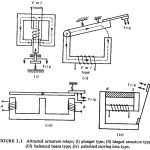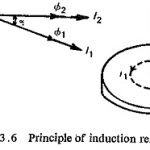Working Principle of Relay Articles:
Relay Classification in Power System Protection: There are various types of Relay Classification in Power System Protection. Normally the actuating quantity is an electrical signal, although sometimes the actuating quantity may be pressure or temperature. The electrical type of protective relays … (Read More)
Types of Electromagnetic Relays: There are two principal Types of Electromagnetic Relays: Attracted armature type; and Induction type. (a) Attracted Armature Type: This includes plunger, hinged armature, balanced beam and moving iron polarized relays. These are the simplest type which respond to a.c. … (Read More)
Induction Relay Torque Equation: In Induction Relay Torque Equation, Two magnetic fluxes Φ1 and Φ2 differing in time phase penetrate through a disc. These alternating fluxes induce emfs e1 and e2 in the disc which lag their respective fluxes by 90°. These emfs … (Read More)
Relay Design and Construction: The Relay Design and Construction is normally divided into the following stages: Selection of the operating characteristics. Selection of proper construction. Design of the contact movement from the point of view of utmost reliability. The relay operating characteristic must match with … (Read More)

